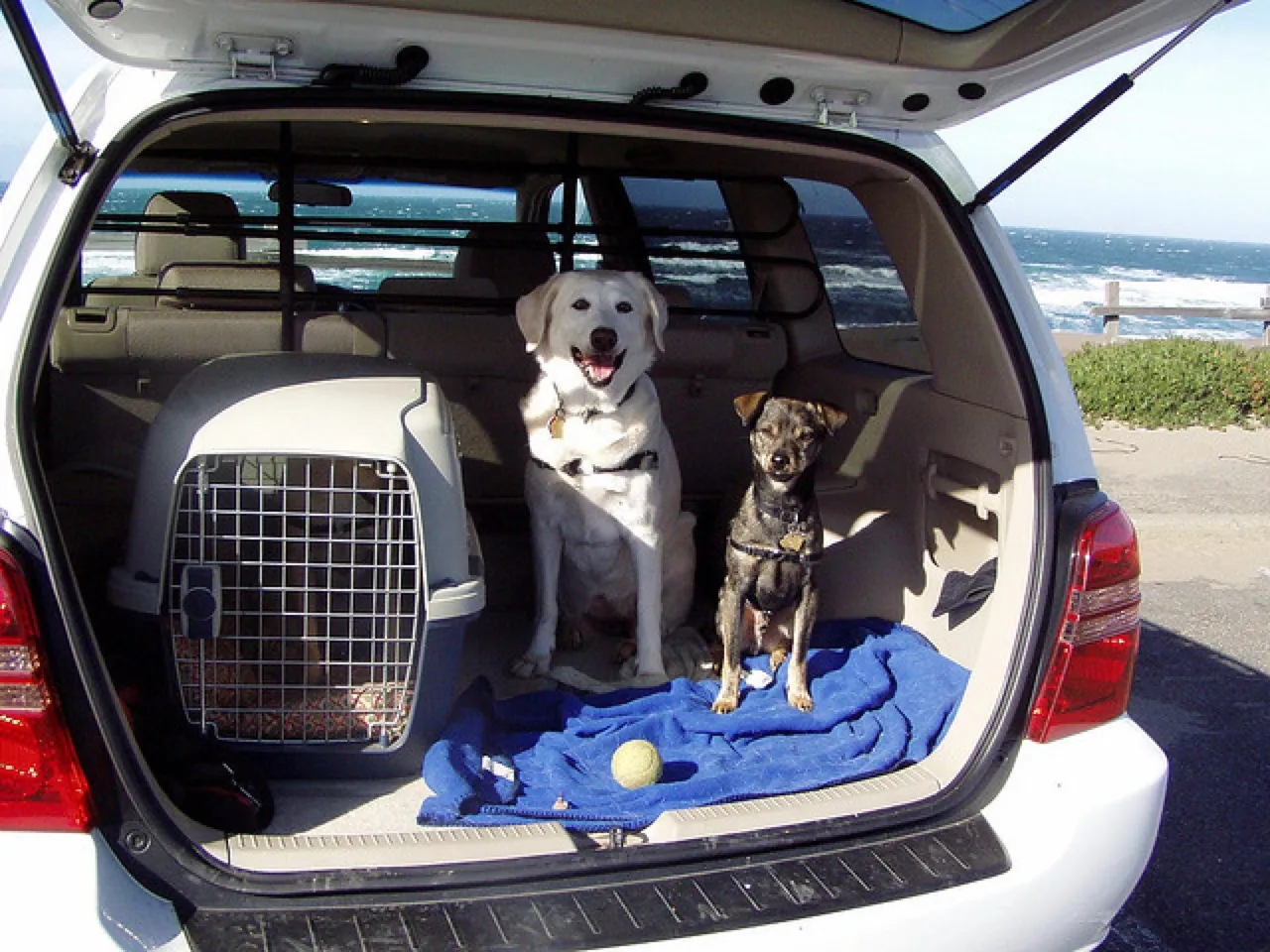Key Takeaways
- Pack the right supplies and get prepared before traveling with a pet.
- Seat harnesses for dogs and carriers for cats ensure your pets’ safety.
- Weigh all the risks before deciding to fly on a plane with your pet.
- Plan ahead for pet-friendly, overnight accommodations and how to handle anxious pets.
Table of Contents
Last updated February 17, 2020
Started by Colleen Paige, an animal advocate and former EMT-Medic, National Pet Travel Safety Day is recognized on January 2nd in the US. The awareness campaign focuses on car safety more than most other travel, and for good reason: Paige has seen firsthand vehicular accidents involving pets and wanted to emphasize safety for the furriest passengers in automobiles.
Whether you’re traveling by plane, train, or automobile, there are several preparation and safety tips to take into account when planning your trip.
Pack the Right Supplies
It’s wise to bring extra potty bags (or possible litter box provisions), travel bowls, treats, towels, an extra collar and leash, and chew toys in addition to your regular emergency equipment (first aid kit, flashlight, etc.). If you’re road tripping with your best bud, remember to pack jugs of water, three or four days’ worth of food, and any necessary medications. Paige brings up a great point about car break-downs in hot temperatures: “It’s vital to have a windshield shade to pull down in the back seat to keep yourself and your pets from heat exhaustion.” And of course, never leave your pet unattended in your car.
Preparing to Travel with a Pet
Dr. Gary Richter (M.S., DVM), author of The Ultimate Pet Health Guide says, “For pets that are not used to travel, take them for short trips for several weeks before leaving. This will help desensitize them to the car. Some pets do experience motion sickness, so consult with your veterinarian for the best options on how to manage this.”
- Get your pet used to traveling. If this is going to be a usual occurrence (and it most likely is, considering trips to the vet), you want your dog or cat to be well behaved in the car. Training your dog by rewarding calm behavior with a short drive to the dog park or a friend’s house for a puppy date works wonders. Cats will slowly acclimate to riding in the car as well.
- Identification is important. Whenever you travel with your pet, make sure they have tags and/or are microchipped. Current ID on the collar is still the easiest way to get your pet back to you.
- Vaccinations should be up to date. Your pet’s good health is necessary when traveling anywhere—either through customs (where shot records are required) or just to a new park, your dog or cat needs to be protected from any possible health threats. Unfamiliar waters (literally) can make your pet sick.
- Take breaks. Hop out of the car every couple hours and allow your dog to stretch her legs and go the bathroom. If your cat is leash-trained, she or he could benefit from a walk in nature as well.
Pet Car Safety
Two major safety precautions include:
- Seat Harnesses for Dogs: Essentially, a seat harness acts much like a human’s seat belt. You want your pup to feel comfortable but secure, fastened in the backseat. And luckily, most seat harnesses are available for purchase at any pet store, like PetSmart.
- Carriers for Cats: The best way to keep a cat safe is to keep her in either a traveling crate or a soft carrier (and this works for dogs as well, if you have the space). Place towels or blankets inside with toys or treats, and rest assured your cat (and any human occupants) will be much safer than if she or he darts under your feet while driving.
Pets can cause chaos in a moving car; they can attempt to jump out of the window or startle you by leaping into your lap. Plus not all dogs and cats enjoy traveling in cars, and the last thing you want is an unsecured animal to have a panic attack. These distractions can lead to accidents, so securing them will not only put your mind at ease, it can also save a life should an accident or sudden stop occur.
Remember: the front seat should be for humans only, for reasons from accidents to airbags, and no hanging out the window! While it seems fun to let your dog stick his head or paws out, he’s at risk of serious injury from flying debris or rocks, sideswiping cars, and even low-hanging trees. These unexpected hazards can really hurt your pet, so it’s best to keep windows up and all furry faces inside.
Rest Stops
When you take a road trip with your pet, it’s important to plan specific stops in order to give your dog a bathroom and water break.
- Find rest stops along your planned route. If you have a Global Positioning System (GPS) unit, use the search function to find rest stops. National Parks can also be good stopping points, as they have human bathrooms and grass for doggy business. Websites like Google Maps be used to find rest stops if you have a pre-determined route.
- Allow your dog to stretch its legs. When dogs sit or lay for extended periods of time, it puts stress on their joints and limbs. Over time, this strain can contribute to obesity, arthritis, and heart conditions. Take your dog for a short walk around the rest area when you stop. Remember to always have your dog on a leash in an unfamiliar environment, especially when there are other dogs around.
- Give your pet water. Dehydration can lead to serious complications, like organ failure, collapse, and heatstroke. Give your dog water at every rest stop, at least every three hours. Make sure to pack your own water – not all rest stop have water fountains. Also, collapsible water bowls save space in luggage and are easy to stow and clean.
- Never release your pet in unfamiliar territory. When on the road, never take your cat out of its carrier! There is no doubt that your cat is faster than you, and will escape. Your dog should always be on a leash at a rest stop as well. Keeping your pet contained at the rest stop will prevent them from being hit by cars, and will keep them from wandering off.
- Bring proper waste disposal equipment. If your dog happens to do their business while at the rest stop, do the right and cleanly (as well as lawful!) thing and pick up after them. While doggy bag dispensers are available at some parks and stops, it’s important to always have a few on hand. Dispose of the waste in a trash can or flush it down a toilet.
- Feed your pet on a break during long drives. For car trips over six hours, you should feed your pet. Make sure to bring proper food and a bowl. Feed your animal during a stop; if you give them food while the car is in motion, it can cause nausea and vomiting.
Road trips with your pet can be a fun bonding experience. However, pets need breaks too! Plan to stop at a rest stop for trips longer than four hours to provide a chance to feed and water your pet, as well as allow them to go to the bathroom. Always keep them on a leash or in their crate, and pick up their messes! With the proper planning, traveling with your pet doesn’t have to be a hassle.
If you’re hitting the road, read our article Keeping Pets Safe in the Car as well for some additional pointers.
Flying with Your Pet
Flights and international travel are much more complicated in terms of preparation. The Humane Society recommends weighing all the risks before attempting to fly with your pets (especially for smoosh-faced breeds such as pugs, French bulldogs, and Persian cats, who might have trouble breathing in those conditions) and remember holiday and summer travel means hectic handling and could then be too stressful for pets.
Most airlines have guidelines for traveling safely with pets – here’s an example from Alaska Airlines. These guidelines include vaccination requirements, health certificates, kennel requirements, date restrictions to fly to certain destinations (usually due to extreme temperatures), breed restrictions (short-nosed dogs cannot ride cargo), and special requirements for different countries, as well as for Hawai’i, a rabies-free state, which can take up to 6 months to clear quarantine.
For pets in the cargo department, make sure that the airline offers a climate controlled baggage compartment. If possible, avoid traveling in extreme hot or cold temperatures, as it can pose a health risk to your pet. Do your research on what airline to go with – not all have the same track record for safely transporting pets in the cargo department. If you worry that your dog might feel at unease, leave a piece of clothing with your sent in the kennel for familiarity and comfort. To make the water last longer and not risk being spilled during transition, freeze the water dish and attach to the kennel as you leave for the airport. Always make sure that your pet’s registration is up to date and that it entails a phone number that is traveling with you, such as your cell phone. It can be a good idea to attach a note with your pet’s name as well as your contact information to the cage, for your peace of mind.
Dr. Richter continues: “If your pet is not used to being in a carrier, put them in their carrier, offer treats and take them on short trips in the car to help acclimate them. Putting pets on a plane usually requires a health certificate from your veterinarian. If your pet must travel in cargo, DO NOT sedate them. Pets are unable to respond to external stresses such as changes in temperatures if they are sedated.”
Hotels, Motels and Rentals: Where to Stay
As more people treat pets as family, the accommodations for pets have opened considerably, and usually an extra fee is all that’s necessary when bringing your friend along. Marriott brands including all Residence Inn and TownePlace Suites hotels are pet-accepting, and make it very easy to find a pet-welcome hotel – simply choose the “pet-friendly” option when filtering through hotels. Hilton’s Home2 Suites is extremely pet-friendly – not only do they allow pets, they also offer feeding bowls, and held nationwide “Yappy Hour” parties on National Pet Day with custom photo props. Finally, Airbnb listings are easily searchable for pet-friendly stays, and most will charge a reasonable fee to permit a pup or cat. If you’re looking for something more indie or local, simply ask the proprietor up front if they accept your dog or cat, and if so, what the additional fee would be.
Anxious and Stressed Pets
Always consult your vet before taking your pet on a plane or administering any sort of anti-anxiety medications. Dr. Richter also recommends testing first: “If needed, natural anti-anxiety products such as CBD oil, lavender, valerian, or rescue remedy can sometimes help. Depending on your pet’s stress level, your veterinarian may recommend a prescription tranquilizer. Regardless of what you use, always test any medication or supplement before you travel. Give it to your pet on a day when you can observe them to make sure there are no adverse reactions, on the plane is not the time to find out your pet is having a problem.”
Plan Ahead
Dr. Richter reminds pet parents that planning ahead is your best action: “Preparations for pet travel begin with planning ahead. Do they need an additional vaccine based on where they are going? If the dog is not on heartworm preventative, is it a problem at the destination?”






